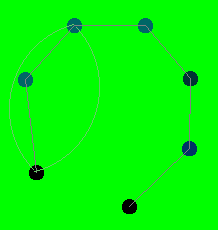
A major success and failure of buliding IWalkways has been the author's realization that encoding design heuristics is a very difficult task. There are clearly ways to improve the visualization of these simple heuristics. First, the cost heuristic only looks at the problem locally and says nothing about the global cost of the solution. But this is not the entire truth since when one node's cost is ajusted it affects its neighbors so there will be a ripple effect to straighten things out if there is a poorly placed node. The detour heuristic, though, is more difficult to express. It also suffers from the same shortcomings that the cost node does-- namely that it does not consider a global smoothness between nodes (see figure 1).

figure 1: a locally smooth path between two endnodes but not a globally smooth solution.
The positive aspects about the difficulty of how to represent this knowedge is that once it is represented, the designer will have a clear understanding of this knowledge. Also, making these tools helps clarify certain heuristics really are useful knowledge to the designer. In the case of Kovacs and Galle's example of the "y" versus "v" aesthetics, a more practical consideration, cost, may be sufficient guidance for user.
Some futher problems about visualization is that it is possible for a scene to get too complex for a designer to understand (figures 2 and 3). In which case, an "expert system" may be useful for helping trim down the information that the designer needs. But just because one visualization technique is not helpul does not mean that we have to resort to expert systems. Although figures 2 and 3 look complex, since one is able to interactively move the center vertex (the one below the light blue vertex) and see which walkways are effected they will get a much clearer picture than what the static images show.
|
|
|
figures 2 and 3: a complex detour of a node with 6 walkways being analyzed.
To conclude, IWalkways enables the designer to interactively see design logic without removing them from any part of the design process.